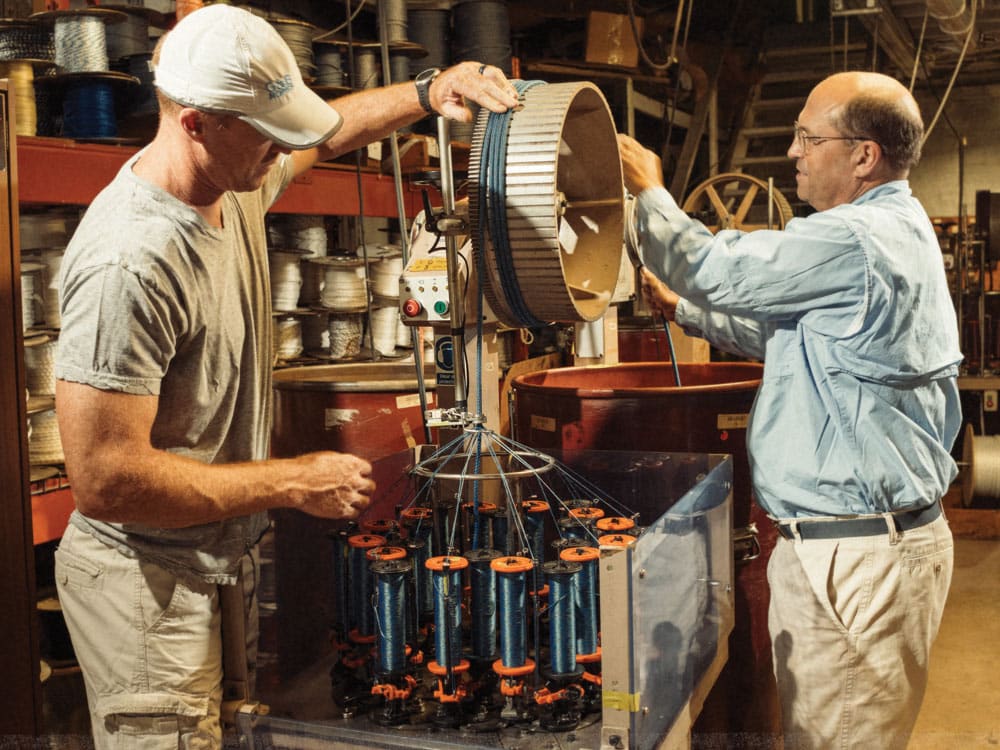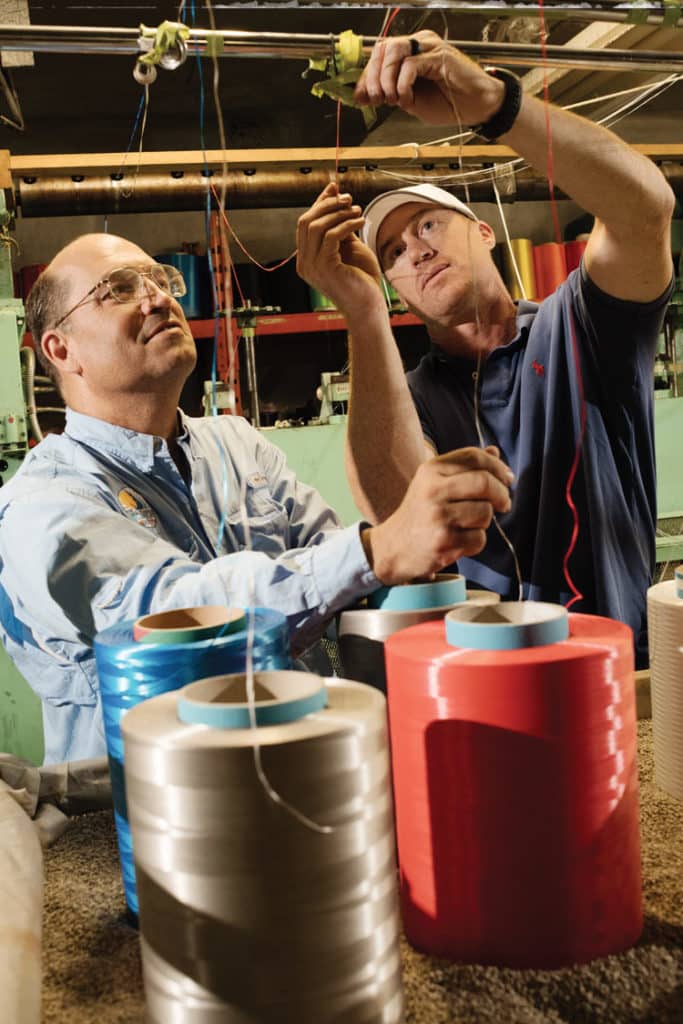
Tim Ray only knew of Tom Allen because of his top-notch reputation among the many classes in which the Allen family has served as boatbuilders, champions and mentors to many. So, unannounced, he walked into the Allen Boat Co. in Buffalo, New York, a few years ago and proposed a trade: business consulting for workshop space. Fast-forward to today; Ray is running a rope-manufacturing facility with Allen. What might seem to be quite a leap from that initial barter is not so far-fetched. Each of them shares a work ethic and deep passion for the sport.
Ray has a degree in environmental science, as well as experience in the field. Besides being able to help companies navigate environmental regulations, he’s the kind of guy who replaces old lights in the shop with LED fixtures, recycles cardboard cordage spools, and even saves line covers stripped for tapered sheets and donates them to a local crafter who makes bracelets and the like.
Tom Allen Jr. is the Allen Boat Co.’s second-generation owner. The company is best known for making one-design boats, including the Lightning, Highlander, Jet 14s and Blue Jays. Allen is the kind of guy who would never let a boat out of the shop unless it was perfect.
Curious about how the Allen family had a rope-manufacturing plant in the first place, I met up with the two of them, and we drove past Niagara Falls to Crystal Beach, Canada, where the plant is located. I know the area as Lake Erie’s home of the Buffalo Canoe Club, which has long enjoyed a deep and talented Lightning fleet, but I had no clue there was a rope factory nearby. Our destination was a cork-insulated building once used to store ice blocks cut from the lake back in the day. You’d never know from the outside, but there in the old icehouse are all the supplies and machinery to make the lines we pull and climbers hang from.
The filaments are the raw material of rope manufacturing. They are wispy thin, like the cobwebs draped across the shop’s nooks and crannies.
When Allen Jr. took over the boatbuilding business from his father in the late 1980s, the elder Allen wasn’t quite ready to retire. The industry was in his blood, he still had plenty of energy and he knew everyone. Timing is everything, and G&B Ropes was up for sale. Allen Sr. bought it and had a good run of it for a while.
When Allen Sr. passed away, his son was busy building boats, so the shop sat dormant for almost 10 years, only occasionally producing rope for the Lightnings he was building. Allen Jr. had been waiting for someone like Ray to come along, and eventually, he brought Ray across the U.S.-Canada border to see the facility firsthand.
When Allen first opened the doors for Ray, he cracked open a time capsule. Dust-covered equipment was waiting patiently to get back to work. Like the solid old icehouse, the machinery was good industrial-quality stuff, and Ray saw past the clutter and cobwebs to see his new calling.

Large iron machines with big gears will last forever with enough grease, and the technique of rope braiding is timeless. Sure, newer equipment has the capability to measure length, and some back-end spooling equipment would save time, but for the low-volume custom needs of the sailing market, these industrial relics do the job just fine.
In one back corner, Allen and Ray show off a large machine nicknamed “Big Bertha.” It needs no warning sign for me to know to keep fingers and loose clothing clear. Bertha twists a bundle of filaments together to make yarn. The filaments are the raw material of rope manufacturing. They are wispy thin, like the cobwebs draped across the shop’s nooks and crannies, but these are much stronger.
Once twisted and spooled, the braiding machines braid the yarns, and like all good rope manufacturers, G&B uses a mix of different filament types for specific applications. There are a lot of braiding machines for cores and jackets, which is handy because there are so many different ropes, and an almost infinite number of possible color, line size and type configurations.
Having some ready to go for common types saves setup time, and a number of different lines can be manufactured at the same time. Covers are braided over a core that has already been braided. The core feeds up from the bottom, and yarns are rhythmically woven around it to form the rope cover. The moving parts unspooling yarn and weaving it into rope is mesmerizing, like watching an open flame.
With his market homework done, Ray decided to differentiate G&B from larger competitors by applying a slightly different technology at the outset. Most rope manufacturers buy their rope already twisted and braided then coated with a protective layer after the braiding. Since Ray already has that capability, he buys the filaments pre-coated, which allows him to braid pre-coated bundles, making a consistent surface throughout the rope’s length. The idea behind the pre-coated filament is that when the line runs through a block it doesn’t chafe against itself, and when the line bends, it does not expose uncoated parts to damaging ultraviolet rays.
It also allows Ray to make the line in unique colors. By coating the line at the yarn level, he can mix colors at the braid level. For example, if the line cover is blue with orange flecks, he can make the core blue with orange flecks so it matches. This is pretty cool when tapering a line so it is the same color, removing a potential source of confusion on the boat.
“How are you intending to use this?” is the first question Ray asks. He can make just about anything, and he knows all the right combinations to meet the buyer’s desires. We sailors know what we want, and often have some idea where to start, but we don’t have the full arsenal, nor the colors, so suffice it to say, we’ll leave the spinning to these guys.









